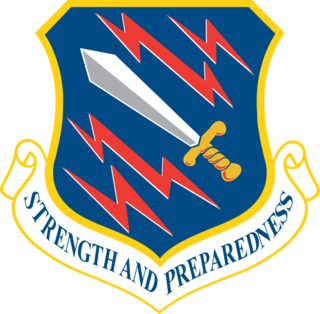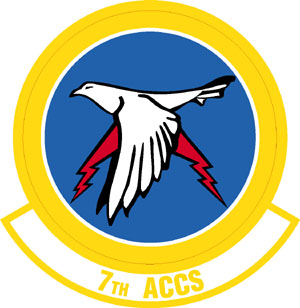
The 50th Wing is an inactive United States Air Force wing.

The 2nd Space Operations Squadron is a United States Space Force unit responsible for operating the Global Positioning System (GPS) satellite constellation, which provides global navigation, time transfer, and nuclear detonation detection. It is a component of Space Operations Command's Positioning, Navigation, and Timing Integrated Mission Delta (Provisional) and headquartered at Schriever Space Force Base, Colorado.

The 21st Wing is an inactive wing of the United States Air Force.

The United States Air Force's 36th Wing is the host wing for Andersen Air Force Base, Guam. It is part of Pacific Air Forces' Eleventh Air Force. The 36th Wing provides day-to-day mission support to more than 9,000 military, civilian, dependent and retired personnel and 15 associate units on the base.

The 379th Air Expeditionary Wing is a provisional United States Air Force unit assigned to Air Combat Command. As a provisional unit, it may be activated or inactivated at any time.

The 21st Space Operations Squadron is a satellite control unit of the Space Delta 6 of the United States Space Force, located at Vandenberg Space Force Base, California. Prior to July 2020, it was part of the 50th Network Operations Group. It operated Onizuka Air Force Station from its formation in 1991 until the closure of the station in 2010.

The 3rd Space Operations Squadron is a United States Space Force unit responsible for conducting on-orbit operations. It is located at Schriever Space Force Base, Colorado.

The United States Space Force's 4th Space Operations Squadron is a satellite operations unit located at Schriever Space Force Base, Colorado. 4 SOPS is part of Space Delta 8 and responsible for command and control of the Milstar/Advanced Extremely High Frequency, Defense Satellite Communications System Phase III, and Wideband Global SATCOM satellite constellations. The 4th Space Operations Squadron's mission is to operate the Space Force's protected and wideband MILSATCOM systems. They provide warfighters global, secure, survivable, strategic and tactical communication during peacetime and throughout the full spectrum of conflict. The squadron also operates three mobile constellation control stations at various locations in conjunction with host partners. At higher readiness levels and during exercises, these personnel deploy with U.S. Strategic Command and U.S. Northern Command respectively.

The United States Air Force's 750th Space Group was a space operations unit located at Onizuka Air Force Station, California. its predecessor was formed on 1 October 1987; it assumed the designation of the 750th Space Group on 30 January 1992; and it was inactivated on 25 June 1999.

The 398th Air Expeditionary Group is a provisional United States Air Force unit assigned to the United States Air Forces in Europe. The 398 AEG may be activated or inactivated at any time.

The 453rd Bombardment Group is an inactive United States Air Force unit that was first organized in June 1943, during World War II, as a Consolidated B-24 Liberator heavy bomber group. After training in the United States, it deployed to England in December 1943, and, starting in February 1944, participated in the strategic bombing campaign against Germany with Eighth Air Force. Its 733d Bombardment Squadron completed 82 consecutive missions without a loss, a record for Eighth Air Force bomber units. James Stewart, of film fame, was group operations officer from 31 March to 1 July 1944. The group was programmed for redeployment to the Pacific and returned to the United States in May 1945 for training, however the Japanese surrender cancelled these plans and the group was inactivated in September 1945.

The 7th Expeditionary Airborne Command and Control Squadron is part of the 379th Air Expeditionary Wing at Al Udeid Air Base, Qatar. It operates the E-8 Joint STARS aircraft, conducting airborne command and control missions. The squadron has performed the airborne command and control mission since 1968, when it was activated in Vietnam. In 1985, the squadron was consolidated with three earlier units: The 7th Ferrying Squadron, which helped deliver aircraft to the Soviet Union from 1942 until 1944; the 7th Combat Cargo Squadron, which performed combat airlift missions in the Southwest Pacific Theater from 1944 until V-J Day, then became part of the Occupation Forces in Japan until inactivating in 1948; and the 7th Air Transport Squadron, Special, which provided airlift support for the United States' special weapons program from 1954 to 1966.

The United States Air Force's 17th Expeditionary Space Control Squadron is a provisional unit of the United States Air Force stationed at Peterson Air Force Base, Colorado.

The 22d Expeditionary Air Refueling Squadron is a provisional United States Air Force unit, assigned to Air Mobility Command. It is engaged in combat operations as part of the Global War on Terrorism in Afghanistan. Its current status and location are undetermined. The squadron's permanent designation is the 22d Air Refueling Squadron.

The 50th Operations Group was a subordinate unit of the 50th Space Wing, and assigned to Air Force Space Command from 1991-2019. The group, redesignated as Space Delta 8 on 24 Jul 2020 is stationed at Schriever Space Force Base, previously Schriever Air Force Base, Colorado.

The 904th Expeditionary Air Refueling Squadron is an inactive United States Air Force unit. It was last assigned to the 320th Bombardment Wing at Mather Air Force Base, California, where it was inactivated on 30 September 1986.

The 32d Air Expeditionary Group is a provisional unit of the United States Air Force (USAF). It is assigned to United States Air Forces in Europe (USAFE) to activate or inactivate at any time. It was last active as the 32d Air And Space Operations Center in December 2006 at Ramstein Air Base, Germany.

Space Operations Command (SpOC) is the United States Space Force's space operations, cyber operations, and intelligence field command. Headquartered at Peterson Space Force Base, Colorado, it consists of its mission deltas, and garrison commands.

Space Delta 3 is a United States Space Force unit responsible for presenting operational combat-ready space electromagnetic warfare forces in support of assigned missions. It is headquartered at Peterson Space Force Base.

Space Delta 6 is a United States Space Force unit which assures access to space through the $6.8 billion Satellite Control Network and defensive cyberspace capabilities for space mission systems.





















